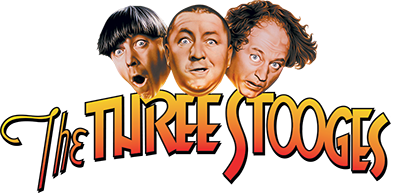Production Information
Title: Hold That Lion
Studio: Columbia
Short Number: 100
Release Date: July 17, 1947
Running Time: 16:27
“Hey, wake up and go to sleep.”
Short Take
In Hold That Lion, The Stooges are the sole heirs to a grandiose inheritance, but the money is in the hands of an underhanded broker named Icabod Slipp (Kenneth MacDonald). One by one, The Stooges confront Slipp in his office. He, in turn, accuses first Larry, then Moe, then Shemp, of being that crook, and successfully flees his office with the money.
The Stooges follow Slipp on board a train. To avoid a conductor after them for tickets, they hide out in a large crate in the baggage car. A lion is also in the crate, and The Stooges run, hiding in a sleeping berth. Moe sticks his foot out through the curtain and the lion licks it, then climbs up in the berth. After bickering with each other The Stooges escape, pulling down all the curtains to the berths and waking everyone up.
As they make their getaway in the confusion, The Stooges spot Slipp and take off after him. They chase him to the baggage car and finally defeat him, reclaiming their inheritance.
Hold That Lion Perspective
Hold That Lion contains as many memorable, even lovable. scenes as any Stooge film: the battle with the filing cabinet, lcabod Slipp knocking out each Stooge in sequence, Shemp speaking in the fishbowl and Larry imitating him. Curly’s cameo appearance, the lion on the train, and Dudley Dickerson’s posterior “Help! I’m losin’ my mind!” Traditional Stooge slapstick is revitalized with over two dozen gouges, slaps, and clangs punctuating every sequence, most of it set up or accompanied by clever exchanges [Shemp: “I can’t see without my glasses.” Moe: “What’s this?” Shemp: “Two dirty fingers.” (GOUGE]: Larry: “My right palm itches. What’s that a sign of?” Moe: “Your hand’s dirty!” [SLAP]. As a unit The Stooges run (“WHOAH!”) and react (“NYAGGH!”) in harmony, and they are confronted with two believable antagonists – lcabod Slipp and a growling lion. These many delights help us forget that the plot seems to derail once The Stooges board the train. Felix Adler has been criticized for writing terrific gags but treating a plot as if its only purpose was to string gags together. This is a deficiency only in some of his films – certainly not Dizzy Detectives-and for those films which are plot-deficient, for instance, Pop Goes the Easel, the gags are so compelling that audiences hardly notice. Technically speaking, the story of The-Stooges-findinglcabod-Slipp-to-regain-their-inheritance does seem to fade from view once The Stooges board the train. They board the train specifically to find Slipp, so the incidents with Curly, the bearded man, the conductor, and the lion certainly seem to delay the action as they search. But as an artist, Adler is equally entitled to the assumption that he had an inspired and well thought out design, and what the lion sequences in particular offer to the plot is a magnificent coincidental symmetry that allows The Stooges to encounter the lion while searching for Slipp and then encounter Slipp while running from the lion. Characterizing The Stooges as not doing anything right except by accident, Adler has Moe simply knock Slipp out with an inadvertent hammer throw to bring the plot to a conclusion. MacDonald’s Slipp is so villainous, he may have deserved a more heroic challenge. But Stooge comedy often depends on absurdity. and Adler’s symmetrical plot design would not seem so strange except in comparison to the more logical ones developed after the arrival of Ed Bernds. Fifty years later, we may assume that Adler’s Slipp/lion/Slipp symmetry belongs to a higher art, as the working title, The Lion and the Louse, suggests. A historical marker should be placed here for Curly’s cameo. We see an uncharacteristic head full of short hair but hear two of his patented sounds [‘Woowoo-woo”; “Rruff!”). And as we look at his visage one last time, his big brothers speak lovingly about him, too (Shemp: “What’s that, a cocker spaniel?” Moe: “I think it’s just a spaniel.”). This is Stooge love at its most heartwarming, appropriate for the only footage in which Moe. Shemp, and Curly Howard appear together. Precious stuff.
Hold That Lion Visual Humor
In the first scene of Hold That Lion, The Stooges have a major slapstick exchange (SLAP, DOUBLE POUND. DOUBLE BONK, NOSE BONK), the most comprehensive thus far in a Shemp film. Shemp’s boxing steps deserve to be admired again and again; he is very light on his feet, agile, and varies his moves well; he threatens. challenges, and seems so confident, and then he is so suddenly and easily knocked out. A file cabinet gag scene was used in the Marx Brothers’ Go West (1940), a lion in the train in Jack White’s Roaring Lions and Wedding Bells (1917). This is the third consecutive film with a chase around crates and boxes. Moe’s conked-out look is very convincing, and it is enhanced with the TWEET sound effect. Sound effects are abundant throughout. The lion scenes are enhanced visually by fast motion and audibly when the lion laughs like a hyena, followed by Moe’s infectious laughter. The lion sequences borrow from the lion scenes of both Three Missing Links and Movie Maniacs [licking the feet; breathing from behind], as well as, from the gorilla scenes in Dizzy Detectives. The Stooges had confronted lions previously as well in You Nazty Spy! and Wee Wee Monsieur, they encountered a monkey on a train in A Pain in the Pullman. When Moe picks up Shemp’s knee, hits Larry, and then kicks Shemp, it is a variation of the set-up kick in / Can Hardly Wait. Shemp featured a glasses gag in his Vitaphone short Dizzy and Daffy (1934 ); cleaning glassless glasses resembles the cleaning of a non-existent windshield in Higher Than a Kite. Teasing the conductor into the woman’s room and tripping him expands upon the similar action in Pop Goes the Easel. Other variations: Shemp saying “Never felt better in my life!” but falling over (Out West); Moe slapping Larry’s hand into his face (Chopper shoving the cream puff into Shemp’s face in Fright Night); Slipp blowing Moe over (Punch Drunks); Moe’s white socks that start above the ankle and end at the ankle (Hoi Polloi); and ducking, making The Stooges hit each other (Restless Knights).
Hold That Lion Verbal Humor
The writing offers internal rhymes with Slipp’s name [Moe: “We’ll slap slip with these ‘subpoenees”‘; Larry & Shemp: “No slippery guy named Slipp … “), set-up gags (Shemp: “Them’s fightin’ words in my country!” Slipp: “All right! Let’s fight!” Shemp: “Well we’re not in my country”; Moe: “We search the train carefully and give everybody a close uh … uh … say, what’s a good word for ‘scrutiny’?” Shemp: “Scrutiny.”), throwaway lines (Moe: “Poor kid must have indigestion”; Shemp: “I feel like a piece of French toast”), support for the visual humor (Moe: “It’s a matter of principle with me. I’m gonna shut that drawer if it’s the last thing I do!”; “Moe: “Stop breathin’ down my neck!” Shemp: “I ain’t breathin’!”) and slapstick (“Fine time to play hopscotch!”). We also get Larry’s literal repetition of Shemp’s indecipherable words from within the fishbowl and Dudley Dickerson’s silent scream. A number of lines have to do with brains and intelligence (Moe: “See? You have to use your brains! [He hits his head on the drawer]; Moe: “Now you’re using a bit of your brain!” (Termites of 1938); and the porter’s “Help! Help! I’m losin’ my mind!” (A Gem of a Jam). Epithets: Moe: “pickle brains” and “goose-brain”; Larry calls Shemp a “nitwit”.
This film offers the first chant in a Shemp film: “We’ll get the filthy lucre, the moola, the geetis/No slippery guy named Slipp/is ever going to cheat us!/ A-zoot, azoat, a-zoe!” We first heard “zoot” in Loco Boy Makes Good. The berth scene has a reprisal of “Wake up and go to sleep,” the first coming from the berth scene in A Pain in the Pullman. References: Larry’s “Here’s where we beard the lion in his den” derives from a line by Sir Walter Scott; Larry’s itching palm refers to getting money; “geetis” is slang for ‘money’: Shemp’s “Rome wasn’t built in a day, and neither was Syracuse” refers not to Syracuse, NY so much as to ancient Sicilian Syracuse, the setting of Rodgers’ and Hart’s The Boys From Syracuse, the musical they referred to in You Nazty Spy!. Other variations: Moe to Larry: “Why don’t you take a bicarbonate of soda?” ( Soup to Nuts]; and “Say a couple a adjectives!” [ Slippery Silks].
Hold That Lion Cast & Crew
| Directed by | Jules White |
|---|---|
| Produced by | Jules White |
| Written by | Felix Adler |
| Starring | Moe Howard Larry Fine Shemp Howard Curly Howard Kenneth MacDonald Emil Sitka Dudley Dickerson Heinie Conklin Victor Travers Blackie Whiteford Tanner The Lion |
| Cinematography | George F. Kelley |
| Edited by | Edwin Bryant |
Hold That Lion Trivia
- This was the only time in Stooge history that the three Horwitz brothers (Moe, Shemp, and Curly) appeared in a short together. Jules White recalled later that Curly just happened to be visiting the set. and that he waved at White from behind a newspaper; this inspired White to develop the cameo
- The title parodies the expression ‘hold that line’
- The introductory theme music has been re-recorded; it now uses the ‘driving,’ quicker tempo introduced in Matri-Phony and discontinued in 1945. But now it leads into a jazzy, syncopated middle section, and ends with a solo flute. This recording will be used intermittently through 1948; thereafter it will be used for all the remaining Columbia shorts, with variations. particularly at the advent of the Joe era in 1957
- The train footage will be reused in Booty and the Beast (1953), the lcabod Slipp sequences in Loose Loot (1953)
- Moe notes that Slipp “gave us the business and behind him is a statue of Mercury, Roman God of Business.
- After The Stooges tear the sleeping car curtain down, we can hear an unemotional extra’s voice saying “Hey look, a lion!”
- The newspaper in the opening scene prints the name of the executor as ‘Elmer Slipp,’ not ‘lcabod Slipp’
- Emil Sitka ( Scrapbook 45) reported that Shemp was so afraid of the lion that he insisted that a glass plate be put between him and the animal, even if the lion “was so sickly he would fall asleep in the middle of a take
Production Notes
Hold That Lion was filmed on January 28-31, 1947 and was the first film produced after the new year


